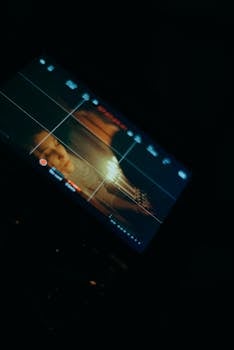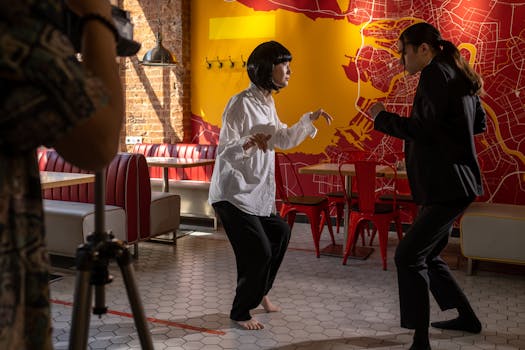TV Shows
Behind the Writers’ Room: Building Great TV Dialogue That Resonates
Discover concrete behind-the-scenes tactics for building great TV dialogue in every writers' room, with actionable scripts, revision tricks, and real examples from top tv shows. See how your favorite lines are made.
Advertisement
Writers’ rooms buzz with energy, laughter, and the hum of collaboration, as creators chase that perfect blend of story and voice that gives tv dialogue its lasting power. Sharp exchanges and effortless banter don’t just appear; they’re carefully crafted through group effort, revision, and an intuitive sense of rhythm built from countless hours together.
TV dialogue has always driven character arcs and fueled plot revelations that keep audiences coming back. Well-written exchanges carry emotion, clarify stakes, and reflect relatable struggles, making shows not just watchable, but memorable long after the credits roll.
Let’s step into the writers’ room and break down how tv dialogue moves from rough ideas to polished, iconic scripts. This exploration uncovers secrets, practical steps, and behind-the-scenes habits used by top writers—and the lessons anyone writing for television will want to hear.
Pinpointing Authentic Voices for Every Character
Writers looking to strengthen tv dialogue start by pinpointing what makes each character unique—speech rhythm, word choices, and conversational quirks. Building this foundation enables later dialogue to ring true and set up memorable episodes.
Writers zero in by listening to their own friends, narrating scenes aloud, and reading scripts side by side to spot tonal mismatches. Being methodical early prevents generic lines and keeps ensemble casts consistent.
Recording Speech Patterns in Table Reads
Actors may highlight something unexpected—a stutter, hesitation, or playful back-and-forth—that becomes essential. Listen closely and jot notes for tweaks to the tv dialogue so each line lands naturally in a scene.
Organize feedback from multiple runs; ask, “Could you imagine anyone else on this show saying that?” If yes, revise. No two voices in stellar tv dialogue should ever be interchangeable.
Letting actors improvise, even for a minute, can unlock hidden rhythms. Preserve great discoveries and integrate them into future scripts for growing authenticity.
Word Choice and Consistency Checks
Use a running glossary of favorite words, slang, and habitual phrases for each character. Mark them on the script or with color-coded highlights. This makes consistency checks fast and actionable.
Schedule regular reviews where the team reads aloud as different characters, catching off-brand words like “frankly” on a teen or “obviously” on a reserved parent.
Chart those catchphrases and unique sayings so, before script lock, every line reads as true to its character as possible. Table reads and peer edits are non-negotiable steps for great tv dialogue.
| Technique | When to Use | Who Benefits | Actionable Takeaway |
|---|---|---|---|
| Table Read | Draft Stage | Writers, Cast | Always read scripts aloud to catch odd rhythms |
| Improv Session | Pre-filming or Rehearsal | Actors, Directors | Record any improvised gems for script inclusion |
| Glossary Check | Each Revision | Script Editors | Highlight unique phrases for each character per script |
| Peer Review | Before Script Lock | Writing Team | Trade roles and spot inconsistencies by voice |
| Voice Note Feedback | After Table Read | Lead Writer | Record immediate fixes and tone notes after read |
Sharpening Exposition Without Losing Engagement
Cutting through exposition is vital if your tv dialogue has to deliver background facts without stopping the story’s momentum. We’ll break this down with direct steps and scripts that sidestep forced info-dumps.
Great tv dialogue uses subtext, action, and suggestion to relay essential info—never overwhelming viewers with dry lectures. Realistic scenes do the heavy lifting by putting facts into conflict or emotion, not empty recitation.
Embedding Facts Into Action
Instead of having a detective summarize the case flatly, let one character recap details as they dig through a suspect’s desk. Action brings dialogue to life while delivering backstory naturally.
Imagine a scene: “Remind me why the mug matters?” asks one character, distracted. The partner answers while sifting evidence, tying tv dialogue directly to their movements and shifting intent.
- Start scenes with action the exposition relates to; it keeps focus and energy high and removes the static feeling of forced storytelling in tv dialogue.
- Have characters react emotionally or with sarcasm, not as dry lecturers. It keeps viewers’ attention by grounding facts in feelings or stakes.
- Write conflicting objectives—one character wants to give info, another wants to leave. Their tension makes the necessary exposition feel urgent and real.
- Split up key facts between two characters arguing their versions. Contrast makes facts clear without spelling everything out in a single block of tv dialogue.
- Cut lines that summarize; replace with lines that reveal through choices (e.g., “He never takes sugar,” instead of “He likes coffee unsweetened”).
Writers should review every info-rich scene and ask: “Can this be expressed through disagreement or active choices instead of a static tell?” It’s a go-to revision rule.
Pacing Reveals Through Reactions
TV dialogue lands more naturally when new facts come out as reactions—surprised, angry, rolled eyes, a hesitant pause. Don’t spell it all out; sometimes a sharp retort replaces two pages of backstory.
Pacing improves when writers let silence or body language pause the info, resisting the urge to over-explain. For example, one character’s nervous laugh may signal what another finally pieces together.
- Write in beats where actors pause, scoff, or change subject. These moments serve as both info and character development within tv dialogue.
- Never use two direct explanations back to back; alternate with reactions or interruptions, making each new piece of information a natural discovery.
- Edit out three consecutive sentences of explanation. Replace at least one with reaction or indirect comment—”You’re not really blaming me for last night, are you?” instead of pure summary.
- Show shifts in tone: a whisper for secrets, a shout for shock. This variety signals importance without hammering audience with details.
- Let background action (shuffling papers, glancing at photos) support tv dialogue, giving context that words alone can’t provide. This removes the need for clunky exposition.
Regular practice: Mark up a scene and count lines between exposition points; no more than two direct “facts” in a row keeps pace lively for true-to-life tv dialogue.
Raising Stakes: Using Conflict to Energize Dialogue
Conflict shapes every strong tv dialogue exchange. Put two characters with opposing goals in a room and sparks fly—delivering memorable lines and subtle layers, all while propelling scenes.
Turning Arguments Into Memorable Exchanges
Take sibling characters: one accuses, “You’re late again.” The other fires back, “At least I show up.” Punchy, personal lines like these reveal relationship history in a flash.
Writers look for real-life inspirations—heated family dinners, office debates—then model arguments in scripts with concise, direct attacks or defenses. Great tv dialogue builds emotional stakes sentence by sentence.
Add specific, observable cues: one twin slams the table, another avoids eye contact. These details make the spoken words sharper and more believable for viewers.
Conflict Without Shouting: Passive Power Plays
Power struggles aren’t always loud. One character might speak quietly to control the conversation or use passive-aggressive humor in tv dialogue. For instance: “I guess you know best, as usual.”
Subtle shifts in phrasing, like delayed responses or feigned politeness, build tension beneath the surface. Silent moments and measured retorts often hit harder than outbursts.
Writers can rehearse scenes both aloud and in writing, asking: Does this feel like a believable exchange two real people would survive, then relive together later?
Balancing Humor and Serious Moments for Maximum Impact
A balanced script leans on tv dialogue to break tension with wit or ground dramatic moments in reality. Writers must switch tones rapidly and purposefully, keeping audiences emotionally invested without slipping into melodrama or forced laughs.
Integrating Natural Jokes in Heavy Scenes
It’s not about shoehorning punchlines—real humor surfaces through sarcasm, playful banter, or self-deprecation, especially in dark moments. For example, “Nice work, Sherlock,” after a blunder lightens the mood without killing the tension.
Writers observe how people deflect in tough times, borrowing phrasing or pacing to keep exchanges sharp and character-driven. It grounds the episode’s big moments in everyday relatability.
Practicing tonal blend in tv dialogue, writers re-read dramatic scenes and add or swap lines for subtle levity, ensuring tonal shifts are earned and believable for the story world.
Letting Serious Beats Land Before Switching Tone
Pauses matter. After a traumatic reveal, holds space for reactions before slipping in humor or relief. Give lines time to resonate, letting tv dialogue breathe so the next moment doesn’t feel rushed.
Actors use timing cues—a tight pause, drawn breath—to reset the room’s emotional temperature. Editing scripts for these moments shapes viewer response and emotional engagement.
A careful blend of humor and gravity spreads across a season, ensuring tv dialogue builds a lived-in world where laughter and tears mix naturally, just like in real life.
Collaborating Efficiently in the Writers’ Room
The heartbeat of great tv dialogue is group synergy. Collaborative sessions refine clunky scenes and spark cross-pollination of ideas. Writers pool strengths—some excel at banter, others at monologues—ensuring every episode shines across genres.
Workshopping Scenes in Real Time
Live read-throughs feature instant feedback and a willingness to experiment. One writer might pitch, “She just storms out,” and another riffs, “Say, ‘That’s not your coat!’ on the way.” The best tv dialogue surfaces from team spontaneity.
Keep sessions structured but loose—run each beat, then pause for suggestions, and break for group edits. Writers leave egos at the door, focusing on what actually serves the show’s goals.
Teams designate a scribe who tracks each tweak to avoid losing great ad-libs in the shuffle—making sure every strong line gets a place in the final script.
Troubleshooting Stalled or Flat Exchanges
Writers lean on the group’s collective perspective when a scene falls flat. Pair up to role-play lines, swapping characters to spot pacing blunders or emotional disconnects in tv dialogue.
Assign at least two writers as “scene doctors”—one questions clarity, the other challenges voice. Proper division of labor lets fresh eyes break through stubborn blocks.
Every problematic scene becomes a mini-project, with a step-by-step fix: identify the scene’s goal, try multiple tones, add subtext, review, and finalize. Collaboration breeds solutions and richer tv dialogue.
Keeping Dialogue Evolving Across a Series
Long-running tv dialogue should never stagnate. Writers plot out how characters’ voices shift as they grow, ensuring speech matures with shifting perspectives, experiences, and relationships over a season arc or years-long run.
Teams map seasonal changes—slang, patterns, emotional beats—to prevent flat repetition. It means an evolving cast sounds as real as the audience following at home, with every script version tested aloud for freshness.
Anticipating Character Growth in Dialogue
Outline key episodes where characters change markedly: a loss, promotion, or new relationship. Rewrite dialogue patterns slightly with each milestone—shyer speech, clipped responses, or braver retorts.
Test whether the changes register for viewers, revising as needed for clarity but always staying true to each character’s journey. Keep catchphrases sparing so change stands out.
Teams hold mid-season reviews, reading flashbacks and current scenes side by side to catch outdated or inconsistent tv dialogue.
Refreshing Banter and Tone Mid-Show
Rotate writers on pairs or teams for episodes, inviting fresh voices and takes on familiar dynamics. This fends off staleness and deepens every relationship’s unique rhythm, keeping tv dialogue lively.
Writers experiment with new settings or scenarios that force odd-couple pairings, shaking up old habits and encouraging growth. For example, sticking longtime enemies on a stakeout can reveal new sides to both voices.
Before locking scripts, assign each team member a quick pass to flag lines that feel overused or bland, ensuring a consistently engaging approach to conversation across seasons.
Final Thoughts on Crafting Memorable TV Dialogue
Any tv show lives and dies by the quality of its dialogue—a reality hard-earned in writers’ rooms stalled over commas, line breaks, and just-right comebacks. The scripts that sing are those that treasure detail, authenticity, and revision as their core mission.
Stellar tv dialogue outlives even its flashiest visuals. It slips into pop culture and everyday conversation, echoing in catchphrases and inside jokes. Staying attuned to evolving voices, stories, and collaborative magic keeps writers pushing boundaries and surprising audiences.
The habits outlined above—rigorous scene work, tangible conflict, fresh humor, evolving voice, and relentless collaboration—build not just dialogue, but legacy. The next time you watch your favorite show, listen closer: that’s the sound of great writing at work.
Trending Topics

The Evolution of Female Leads in Modern Cinema: Breaking Stereotypes and Shaping Stories
Follow the rise of female leads in cinema who broke stereotypes, expanded depth, and redefined screen representation forever.
Keep Reading
Famous Film Scores That Instantly Set the Mood
Experience film scores that guide emotion, intensify scenes, and remain engraved in memory long after the credits roll.
Keep ReadingYou may also like

Iconic Movie Scenes That Were Never in the Script
Explore iconic movie scenes that were improvised or accidental yet became legendary parts of cinematic storytelling forever.
Keep Reading
Film Genres Explained: From Noir to New Wave
Understand film genres from noir’s shadows to New Wave’s style, tracing how storytelling traditions evolved across generations.
Keep Reading
